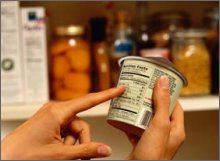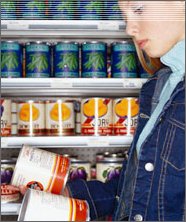Food Nutrition Labels: Six Catches You Need to Know
by www.SixWise.com
Most foods are required to carry nutrition labels to provide,
as the U.S. Food and Drug Administration (FDA) says, "distinctive,
easy-to-read formats that enable consumers to more quickly
find the information they need to make healthful food choices."
But despite being regulated by the FDA and the U.S. Department
of Agriculture, food manufacturers can, and do, get away with
adding confusing or deceptive information to the labels. Sometimes
this is done inadvertently, but often it's done with the specific
intention of making you think the food is better for you than
it actually is.
|

Even seemingly "healthy" foods might contain
hidden, unsavory ingredients.
|
Reading the labels can be tricky, so here are the six top
nutrition label "catches" to watch out for on your
next trip to the grocery store.
1. Serving Size. Many processed foods that are packaged
as a single serving actually contain two or more servings.
According to the Nutrition Labeling and Education Act (NLEA)
of 1990, a food item in a relatively small container may be
labeled as a single serving if the entire contents can "reasonably
be expected to be consumed in a single-eating occasion."
However, there is often a discrepancy.
Consider "Big Grab" potato chips or Doritos and
"Big Gulp" drinks. Most people buy them with the
intention of eating or drinking the whole thing. But an
average serving of a soft drink is 12 ounces. Some of the
Big Gulp drinks can be up to 64 ounces--more than five cans
of soda! As for potato chips, a serving size can vary
depending on the package. A single-serving snack size bag
of chips, of course, has fewer calories than a larger, but
still single-serving, size of the same snack.
Other items to watch out for include large muffins (which
often contain two servings), bagels, "individual"
ice cream containers (some contain 4 servings), and personal
size pizzas.
2. Exempt Ingredients. Food labels list ingredients
in descending order. The most prevalent ingredient is first,
the least is last. However, ingredients that constitute less
than 2 percent can be listed in any order after the heading
"contains less than 2% of the following."
Other ingredients called "incidental
additives" do not have to be listed on labels. These
include substances transferred to food via packaging and "ingredients
of other ingredients" that are present at "insignificant
levels" and have no "technical or functional effect."
Natural and artificial flavors are also often grouped together
under one name, and manufacturers aren't required to disclose
what "artificial flavors" really means. The exception
here is a new ruling by the FDA, to begin January 1, 2006,
that states any food containing a "major food allergen"
must have it listed on the label (whether or not its part
of flavoring or incidental additives). Major food allergens
include milk, eggs, peanuts, tree nuts, fish, shellfish, soy
and wheat, as well as food ingredients containing proteins
derived from any of these food categories.
3. All Natural. Food products that claim to be all
natural may in fact include unnatural ingredients. According
to Mike Adams, the "Health Ranger," "[The term
all-natural] actually has no nutritional meaning whatsoever
and isn't truly regulated by the FDA."
|

Comparing nutrition labels will often allow you to
choose the healthier brand of your favorite foods.
|
"The reality is that natural isn't always safe, and
products with the 'natural' labeling are not required by law
to contain only natural ingredients,'' said Linda Golodner,
president of the National Consumers League. " ...
Consumers think of words like 'safe' and 'good for me' when
they think of natural, but across the board -- from prescription
drugs to food products -- many of these natural claims are
misleading at best.''
4. Free From ... The FDA allows food manufacturers
to round to zero any ingredient that accounts for less than
0.5 grams per serving. So while a product may claim to be
"gluten-free" or "alcohol-free," it can
legally contain up to 0.5 grams per serving. While this may
seem like an insignificant amount, over time this small fraction
can add up.
Case in point, many food products that claim to have no dangerous
trans fats list partially hydrogenated oil in their ingredients
label. Partially hydrogenated oil creates trans fats, so these
labels may be taking advantage of the rounding to zero option.
"If there's less than 0.5 gram of trans fats per serving,
the food manufacturer may round down to zero," says D.
Milton Stokes, R.D., a New York City-based nutritionist. "It's
an FDA rule, and it happens with all foods."
5. Unfamiliar Terms for Unsavory Ingredients. Food
manufacturers are known to use "clean labels," in
which they hide ingredients they know consumers would rather
not have in their foods under names they won't recognize.
For instance, if you're trying to avoid MSG,
you need to look for all of the following terms, as they all
contain MSG:
- Autolyzed yeast
- Calcium caseinate
- Gelatin
- Glutamate
- Glutamic acid
- Hydrolyzed protein
- Monopotassium glutamate
|
- Monosodium glutamate
- Sodium caseinate
- Textured protein
- Yeast extract
- Yeast food
- Yeast Nutrient
|
6. Misleading Ingredient Claims. Sometimes, foods
that claim to include healthy ingredients actually don't contain
them, or only contain them in miniscule amounts. Common offenders
are blueberry waffles with no blueberries and strawberry yogurt
with no strawberries. The Center for Science in the Public
Interest (CSPI) recently asked the FDA to "immediately
stop misleading food labels," including:
-
Kellogg's Eggo Nutri-Grain Pancakes: The label says they're
made with whole wheat and whole grain, but they're made
primarily of white flour and contain more high-fructose
corn syrup than whole wheat or whole grain.
-
Betty Crocker Super Moist Carrot Cake Mix: Contains only
carrot powder as the 19th ingredient on the label.
-
Gerber Graduates for Toddlers Fruit Juice Snacks: The
primary ingredients are corn syrup and sugar.
"Food manufacturers are shamelessly tricking consumers
who are trying to eat more fruits, vegetables, and whole grains,"
said CSPI director of legal affairs Bruce Silverglade. "Too
many processed foods contain only token amounts of the healthful
ingredients highlighted on labels and are typically loaded
with fats, refined sugars, refined flour, and salt, in various
combinations."
Recommended Reading
How
Many Insect Parts and Rodent Hairs are Allowed in Your Food?
More Than You Think ... and Maybe Than You Want to Know!
Those
Who Don't Diet are Better at Improving Health Than Those Who
Do Diet
Sources
Allergen
Labeling Becomes Law
Stop
Labeling Lies
Men's
Health
All-Natural
Claim on Food Labels is Often Deceptive
Center
for Science in the Public Interest